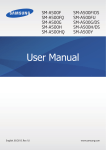Download Samsung SM-G531F User Manual(Lollipop)
Transcript
SM-G531F User Manual English (EU). 06/2015. Rev.1.0 www.samsung.com Table of Contents Read me first Network connectivity Getting started 31 Mobile data 31Wi-Fi 32 Tethering and Mobile hotspot 6 7 9 Personalising Package contents Device layout Using the SIM or USIM card and battery 14 Using a memory card 16 Turning the device on and off 16 Locking and unlocking the screen 34 36 37 37 Managing the Home and Apps screens Setting wallpaper and ringtones Changing the screen lock method Setting up accounts Basics Phone 17 20 24 25 26 27 29 29 30 38 Making calls 39 Receiving calls 40 Options during calls Using the touch screen Home screen layout Notifications panel Opening apps Installing or uninstalling apps Entering text Screen capture My Files Power saving feature Contacts 42 Adding contacts 42 Importing and exporting contacts 43 Searching for contacts 2 Table of Contents Connecting with other devices Messages & email 44Messages 45Email Camera 65Bluetooth 67 Wi-Fi Direct 69NFC 71 Mobile printing 48 Basic shooting 50 Shooting modes 53 Camera settings Device & data manager 72 Transferring data from your previous device 73 Using the device as a removable disk for data transfer 74 Updating the device 75 Backing up and restoring data 75 Performing a data reset Gallery 55 Viewing content on the device Useful apps and features 56 S Planner 57Internet 58Video 58Calculator 59Clock 60Memo 61 Voice Recorder 62Radio 63 Google apps Settings 76 About Settings 76Connections 80Device 83Personal 85System Troubleshooting 3 Read me first Please read this manual before using the device to ensure safe and proper use. • Descriptions are based on the device’s default settings. • Some content may differ from your device depending on the region, service provider, or device’s software. • Content (high quality content) that requires high CPU and RAM usage will affect the overall performance of the device. Apps related to the content may not work properly depending on the device’s specifications and the environment that it is used in. • Samsung is not liable for performance issues caused by apps supplied by providers other than Samsung. • Samsung is not liable for performance issues or incompatibilities caused by edited registry settings or modified operating system software. Attempting to customise the operating system may cause the device or apps to work improperly. • Software, sound sources, wallpapers, images, and other media provided with this device are licensed for limited use. Extracting and using these materials for commercial or other purposes is an infringement of copyright laws. Users are entirely responsible for illegal use of media. • You may incur additional charges for data services, such as messaging, uploading and downloading, auto-syncing, or using location services depending on your data plan. For large data transfers, it is recommended to use the Wi-Fi feature. • Default apps that come with the device are subject to updates and may no longer be supported without prior notice. If you have questions about an app provided with the device, contact a Samsung Service Centre. For user-installed apps, contact service providers. • Modifying the device’s operating system or installing softwares from unofficial sources may result in device malfunctions and data corruption or loss. These actions are violations of your Samsung licence agreement and will void your warranty. 4 Read me first Instructional icons Warning: situations that could cause injury to yourself or others Caution: situations that could cause damage to your device or other equipment Note: notes, usage tips, or additional information 5 Getting started Package contents Check the product box for the following items: • Device • Battery • Quick start guide • The items supplied with the device and any available accessories may vary depending on the region or service provider. • The supplied items are designed only for this device and may not be compatible with other devices. • Appearances and specifications are subject to change without prior notice. • You can purchase additional accessories from your local Samsung retailer. Make sure they are compatible with the device before purchase. • Use only Samsung-approved accessories. Using unapproved accessories may cause the performance problems and malfunctions that are not covered by the warranty. • Availability of all accessories is subject to change depending entirely on manufacturing companies. For more information about available accessories, refer to the Samsung website. 6 Getting started Device layout Proximity sensor Earpiece Front camera Power button Touch screen Home button Back button Recent apps button Microphone Multipurpose jack Headset jack Flash GPS antenna Rear camera Volume button Back cover Speaker NFC antenna (on the battery) Main antenna 7 Getting started • Do not cover the antenna area with your hands or other objects. This may cause connectivity problems or drain the battery. • Using a Samsung-approved screen protector is recommended. Unapproved screen protectors may cause the sensors to malfunction. • Do not allow water to contact the touch screen. The touch screen may malfunction in humid conditions or when exposed to water. Buttons Button Function Power • Press and hold to turn the device on or off. • Press to turn on or lock the screen. • Tap to open the list of recent apps. Recent apps • Tap and hold to access additional options for the current screen. • Press to turn on the screen while the screen is locked. Home • Press to return to the Home screen. • Press and hold to launch Google. Back • Tap to return to the previous screen. Volume • Press to adjust the device volume. 8 Getting started Using the SIM or USIM card and battery Installing the SIM or USIM card and battery Insert the SIM or USIM card provided by the mobile telephone service provider, and the included battery. • Only microSIM cards work with the device. • Some LTE services may not be available depending on the service provider. For more information about service availability, contact your service provider. 1 Remove the back cover. Be careful not to damage your fingernails when you remove the back cover. Do not bend or twist the back cover excessively. Doing so may damage the cover. 9 Getting started 2 Insert the SIM or USIM card with the gold-coloured contacts facing downwards. • Do not insert a memory card into the SIM card slot. If a memory card happens to be lodged in the SIM card slot, take the device to a Samsung Service Centre to remove the memory card. • Use caution not to lose or let others use the SIM or USIM card. Samsung is not responsible for any damages or inconveniences caused by lost or stolen cards. 3 Insert the battery with the battery’s gold-coloured contacts properly aligned with the device’s contacts. 2 1 10 Getting started 4 Replace the back cover. Removing the SIM or USIM card and battery 1 Remove the back cover. 2 Pull out the battery. 3 Pull out the SIM or USIM card. 11 Getting started Charging the battery Use the charger to charge the battery before using it for the first time. A computer can be also used to charge the battery by connecting them via the USB cable. Use only Samsung-approved chargers, batteries, and cables. Unapproved chargers or cables can cause the battery to explode or damage the device. • When the battery power is low, the battery icon appears empty. • If the battery is completely discharged, the device cannot be turned on immediately when the charger is connected. Allow a depleted battery to charge for a few minutes before turning on the device. • If you use multiple apps at once, network apps, or apps that need a connection to another device, the battery will drain quickly. To avoid disconnecting from the network or losing power during a data transfer, always use these apps after fully charging the battery. 1 Connect the USB cable to the USB power adaptor and then plug the end of the USB cable into the multipurpose jack. Connecting the charger improperly may cause serious damage to the device. Any damage caused by misuse is not covered by the warranty. 12 Getting started 2 Plug the USB power adaptor into an electric socket. • The device can be used while it is charging, but it may take longer to fully charge the battery. • If the device receives an unstable power supply while charging, the touch screen may not function. If this happens, unplug the charger from the device. • While charging, the device may heat up. This is normal and should not affect the device’s lifespan or performance. If the battery gets hotter than usual, the charger may stop charging. • If the device is not charging properly, take the device and the charger to a Samsung Service Centre. 3 After fully charging, disconnect the device from the charger. First unplug the charger from the device, and then unplug it from the electric socket. Do not remove the battery before removing the charger. This may damage the device. To save energy, unplug the charger when not in use. The charger does not have a power switch, so you must unplug the charger from the electric socket when not in use to avoid wasting power. The charger should remain close to the electric socket and easily accessible while charging. Reducing the battery consumption Your device provides options that help you save the battery power. By customising these options and deactivating features in the background, you can use the device longer between charges: • When you are not using the device, switch to sleep mode by pressing the Power button. • Close unnecessary apps using the task manager. • Deactivate the Bluetooth feature. • Deactivate the Wi-Fi feature. • Deactivate auto-syncing of apps. • Decrease the backlight time. • Decrease the screen brightness. 13 Getting started Using a memory card Installing a memory card Your device accepts memory cards with maximum capacities of 64 GB. Depending on the memory card manufacturer and type, some memory cards may not be compatible with your device. • Some memory cards may not be fully compatible with the device. Using an incompatible card may damage the device or the memory card, or corrupt the data stored in it. • Use caution to insert the memory card right-side up. • The device supports the FAT file system for memory cards. When inserting a card formatted in a different file system, the device asks to reformat the memory card. • Frequent writing and erasing of data shortens the lifespan of memory cards. • When inserting a memory card into the device, the memory card’s file directory appears in the My Files → SD card folder. 1 Remove the back cover. 2 Insert a memory card with the gold-coloured contacts facing downwards. 3 Replace the back cover. 14 Getting started Removing the memory card Before removing the memory card, first unmount it for safe removal. On the Home screen, tap Apps → Settings → Storage → Unmount SD card. 1 Remove the back cover. 2 Pull out the memory card. 3 Replace the back cover. Do not remove the memory card while the device is transferring or accessing information. Doing so can cause data to be lost or corrupted or can damage the memory card or device. Samsung is not responsible for losses that result from the misuse of damaged memory cards, including the loss of data. Formatting the memory card A memory card formatted on a computer may not be compatible with the device. Format the memory card on the device. On the Home screen, tap Apps → Settings → Storage → Format SD card → FORMAT SD CARD → ERASE EVERYTHING. Before formatting the memory card, remember to make backup copies of all important data stored in the device. The manufacturer’s warranty does not cover loss of data resulting from user actions. 15 Getting started Turning the device on and off Press and hold the Power button for a few seconds to turn on the device. When you turn on your device for the first time or after performing a data reset, follow the onscreen instructions to set up your device. To turn off the device, press and hold the Power button, and then tap Power off. Follow all posted warnings and directions from authorised personnel in areas where the use of wireless devices is restricted, such as aeroplanes and hospitals. Locking and unlocking the screen Pressing the Power button turns off the screen and locks it. Also, the screen turns off and automatically locks if the device is not used for a specified period. To unlock the screen, press the Power button or the Home button and flick your finger in any direction within the unlock screen area. You can change the unlock code to unlock the screen. Refer to Changing the screen lock method for more information. 16 Basics Using the touch screen • Do not allow the touch screen to come into contact with other electrical devices. Electrostatic discharges can cause the touch screen to malfunction. • To avoid damaging the touch screen, do not tap it with anything sharp or apply excessive pressure to it with your fingertips. • The device may not recognise touch inputs close to the edges of the screen, which are outside of the touch input area. • Leaving the touch screen idle for extended periods may result in afterimages (screen burn-in) or ghosting. Turn off the touch screen when you do not use the device. • It is recommended to use fingers when you use the touch screen. Tapping To open an app, to select a menu item, to press an on-screen button, or to enter a character using the keyboard on the screen, tap it with a finger. 17 Basics Tapping and holding Tap and hold an item or the screen for more than 2 seconds to access available options. Dragging To move an item, tap and hold it and drag it to the target position. Double-tapping Double-tap on a webpage or image to zoom in. Double-tap again to return. 18 Basics Flicking Flick left or right on the Home screen or the Apps screen to see another panel. Flick up or down to scroll through a webpage or a list of items, such as contacts. Spreading and pinching Spread two fingers apart on a webpage, map, or image to zoom in a part. Pinch to zoom out. 19 Basics Home screen layout Home screen The Home screen is the starting point for accessing all of the device’s features. It displays widgets, shortcuts to apps, and more. Widgets are small apps that launch specific app functions to provide information and convenient access on your Home screen. To view other panels, scroll left or right, or tap one of the screen indicators at the bottom of the screen. To customise the Home screen, refer to Managing the Home screen. A widget A folder An app A screen indicator Favourite apps 20 Basics Home screen options On the Home screen, tap and hold an empty area, or pinch your fingers together to access the available options. 21 Basics Apps screen The Apps screen displays icons for all apps, including newly installed apps. On the Home screen, tap Apps to open the Apps screen. To view other panels, scroll left or right, or select a screen indicator at the bottom of the screen. To customise the Apps screen, refer to Managing the Apps screen. Access additional options. An app Screen indicators 22 Basics Indicator icons Indicator icons appear on the status bar at the top of the screen. The icons listed in the table below are most common. The status bar may not appear at the top of the screen in some apps. To display the status bar, drag down from the top of the screen. Icon Meaning No signal Signal strength Roaming (outside of normal service area) GPRS network connected EDGE network connected UMTS network connected HSDPA network connected HSPA+ network connected / LTE network connected Wi-Fi connected Bluetooth feature activated GPS activated Call in progress Missed call Synced with the web New text or multimedia message Alarm activated Mute mode activated Vibration mode activated Flight mode activated Error occurred or caution required Battery power level 23 Basics Notifications panel Using the notifications panel When you receive new notifications, such as messages or missed calls, indicator icons appear on the status bar. To see more information about the icons, open the notifications panel and view the details. To open the notifications panel, drag the status bar downwards. To close the notifications panel, drag the bar from the bottom of the screen upwards. You can use the following functions on the notifications panel. Launch Settings. Activate or deactivate options. Tap and hold a button to view more detailed settings. Adjust the brightness. Tap a notification and perform various actions. Clear all notifications. 24 Basics Using the quick setting buttons You can activate or deactivate some features on the notifications panel. Tap the following options to activate or deactivate them. You can view more detailed settings if you tap and hold a button. • Wi-Fi: Refer to Wi-Fi for more information. • Location: Refer to Location for more information. • Sound / Vibrate / Mute: Select a sound mode. • Screen rotation: Allow or prevent the interface from rotating when you rotate the device. Some apps do not allow screen rotation. • Bluetooth: Refer to Bluetooth for more information. • Mobile data: Refer to Data usage or Mobile networks for more information. • U. power saving: Refer to Ultra power saving mode for more information. • Mobile hotspot: Refer to Tethering and Mobile hotspot for more information. • NFC: Refer to NFC for more information. • Sync: When you activate this feature, the device automatically syncs apps, such as calendar or email. • Do not disturb: Activate or deactivate blocking mode. In blocking mode, the device will block notifications. To select which notifications will be blocked, tap Settings → Sounds and notifications → Do not disturb. • Flight mode: Refer to Flight mode for more information. Opening apps On the Home screen or the Apps screen, select an app icon to open it. To open the list of recently-used apps, tap and select an app icon to open. Closing an app Tap and drag an app icon to the left or right to close it. To close all running apps, tap → . 25 Basics Installing or uninstalling apps Galaxy Apps Use this app to purchase and download apps. Tap Galaxy Apps on the Apps screen. This app may not be available depending on the region or service provider. Installing apps Browse apps by category or tap SEARCH to search for a keyword. Select an app to view information about it. To download free apps, tap INSTALL. To purchase and download apps where charges apply, tap the button that shows the app’s price. To change the auto update settings, tap then select an option. → Settings → Auto update apps, and Play Store Use this app to purchase and download apps. Tap Play Store on the Apps screen. Installing apps Browse apps by category or tap to search for a keyword. Select an app to view information about it. To download free apps, tap INSTALL. To purchase and download apps where charges apply, tap the price and follow the on-screen instructions. To change the auto update settings, tap then select an option. 26 → Settings → Auto-update apps, and Basics Managing apps Uninstalling or disabling apps To disable default apps, open the Apps screen and tap → Uninstall/disable apps. appears on the apps that you can disable. Select an app and tap OK. To uninstall downloaded apps, open the Apps screen and tap → Downloaded apps → → Uninstall. Alternatively, on the Apps screen, tap Settings → Application manager, select an app, and then tap UNINSTALL. Enabling apps On the Apps screen, tap → Show disabled apps, select apps, and then tap Done. Alternatively, on the Apps screen, tap Settings → Application manager, scroll to DISABLED, select an app, and then tap ENABLE. • Hiding apps: Hide apps in the Apps screen only. You can continue to use hidden apps. • Disabling apps: Disable selected default apps that cannot be uninstalled from the device. You cannot use disabled apps. • Uninstalling apps: Uninstall downloaded apps. Entering text Keyboard layout A keyboard appears automatically when you enter text to send messages, create memos, and more. Text entry is not supported in some languages. To enter text, you must change the input language to one of the supported languages. Enter uppercase. For all caps, tap it twice. Delete a preceding character. Enter numbers and punctuation marks. Change the keyboard settings. Break to the next line. Enter a space. 27 Basics Changing the input language Tap → Select input languages, and then select the languages to use. If you select two or more languages, you can switch between the input languages by sliding the space key left or right. Changing the keyboard layout Tap , select a language under Input languages, and then select a keyboard layout to use. On 3x4 keyboard, a key has three or four characters. To enter a character, tap the corresponding key repeatedly until the desired character appears. Using additional keyboard functions Tap and hold to use various functions. Other icons may appear instead of on the last function that was used. depending • : Enter text by voice. Start or pause entering text by voice. Open the keyboard. • : Change the keyboard settings. • : Enter emoticons. Copying and pasting 1 Tap and hold over text. 2 Drag or to select the desired text, or tap Select all to select all text. 3 Tap Copy or Cut. The selected text is copied to the clipboard. 4 Tap and hold at the point where the text is to be inserted and tap Paste. 28 Basics Screen capture Capture a screenshot while using the device. Press and hold the Home button and the Power button simultaneously. The image is saved in the Gallery → Screenshots folder. After capturing a screenshot, you can edit the image and share it with others. It is not possible to capture a screenshot while using some apps. My Files About My Files Use this app to access various files stored in the device. Tap My Files on the Apps screen. Search for files or folders. Access additional options. View files by categories. View the download history. View files stored in the device. 29 Basics Power saving feature Ultra power saving mode Use this mode to extend the device’s battery power. In ultra power saving mode, the device performs the following: • Restricts the available apps to essential and selected apps only. • Deactivates the mobile data connection when the screen turns off. • Deactivates the Wi-Fi and Bluetooth features. On the Apps screen, tap Settings → Ultra power saving mode, and tap the Ultra power saving mode switch to activate it. To add an app to the Home screen, tap and select an app. To change the settings for ultra power saving mode, such as network connectivity or sound, tap → Settings. To deactivate ultra power saving mode, tap → Disable ultra power saving mode. The estimated maximum standby time shows the time remaining before the battery power runs out if the device is not used. Standby time may vary depending on your device settings and operating conditions. 30 Network connectivity Mobile data Connect the device to a mobile network to use the Internet or share media files with other devices. Refer to Data usage for additional options. On the Apps screen, tap Settings → Data usage, and then tick Mobile data. Wi-Fi Connect the device to a Wi-Fi network to use the Internet or share media files with other devices. Refer to Wi-Fi for additional options. Turn off Wi-Fi to save the battery when not in use. 1 On the Apps screen, tap Settings → Wi-Fi, and then tap the Wi-Fi switch to activate it. 2 Select a network from the Wi-Fi networks list. Networks that require a password appear with a lock icon. 3 Tap CONNECT. Once the device connects to a Wi-Fi network, the device will reconnect to that network each time it is available without requiring a password. To prevent the device connecting to the network automatically, select it from the list of networks and tap FORGET. 31 Network connectivity Tethering and Mobile hotspot About tethering and mobile hotspots Use this feature to share the device’s mobile data connection with computers and other devices if an Internet connection is unavailable. Connections can be made via Wi-Fi, USB, or Bluetooth. You may incur additional charges when using this feature. Using the mobile hotspot Use your device as a mobile hotspot to share your device’s mobile data connection with other devices. 1 On the Apps screen, tap Settings → Tethering and Mobile hotspot → Mobile hotspot. 2 Tap the Mobile hotspot switch to activate it. • appears on the status bar. Other devices can find your device in the Wi-Fi networks list. • To set a password for the mobile hotspot, tap → Configure hotspot and select the level of security. Then, enter a password and tap SAVE. 3 On the other device’s screen, search for and select your device from the Wi-Fi networks list. 4 On the connected device, use the device’s mobile data connection to access the Internet. 32 Network connectivity Using USB tethering Share the device’s mobile data connection with other devices via a USB cable. 1 On the Apps screen, tap Settings → Tethering and Mobile hotspot. 2 Connect your device to the computer via the USB cable. 3 Tick USB tethering. appears on the status bar when the two devices are connected. 4 On the computer, use your device’s mobile data connection. Using Bluetooth tethering Share the device’s mobile data connection with other devices via Bluetooth. Ensure that the computer that you connect to supports the Bluetooth feature. 1 Pair your device with the other device via Bluetooth. Refer to Pairing with other Bluetooth devices for more information. 2 On the Apps screen of your device, tap Settings → Tethering and Mobile hotspot. 3 Tick Bluetooth tethering. 4 On the connected device, open the Bluetooth settings screen, tap → Internet access. appears on the status bar when the two devices are connected. 5 On the connected device, use the device’s mobile data connection to access the Internet. The connection methods may vary depending on the connected devices. 33 Personalising Managing the Home and Apps screens Managing the Home screen Adding items Tap and hold an app from the Apps screen, and then drag it to the Home screen. To add widgets, open the Home screen, tap and hold an empty area, tap Widgets, tap and hold a widget, and then drag it to the Home screen. Moving and removing an item Tap and hold an item on the Home screen, and then drag it to a new location. To move the item to another panel, drag it to the side of the screen. You can also move frequently-used apps to the shortcuts area at the bottom of the Home screen. To remove an item, tap and hold the item. Then, drag it to Remove that appears at the top of the screen. Creating a folder 1 On the Home screen, tap and hold an app, and then drag it to Create folder that appears at the top of the screen. 2 Enter a folder name. To add more apps to the folder, tap and hold another app, and then drag it to the folder. 34 Personalising Managing panels On the Home screen, tap and hold an empty area to add, move, or remove a panel. To add a panel, scroll left to the last panel, and then tap . To move a panel, tap and hold a panel preview, and then drag it to a new location. To remove a panel, tap and hold a panel preview, and then drag it to Remove at the top of the screen. To set a panel as the main Home screen, tap . Managing the Apps screen Changing the sorting method On the Apps screen, tap → View as and select a sorting method. Hiding apps Hide apps that you do not want to see on the Apps screen. On the Apps screen, tap → Hide apps, select apps, and then tap Done. To display hidden apps, tap → Show hidden apps, select apps, and then tap Done. Moving items On the Apps screen, tap → Edit. Tap and hold an item and drag it to a new location. To move the item to another panel, drag it to the side of the screen. To move an item to a new panel, drag it to Create page that appears at the top of the screen. 35 Personalising Setting wallpaper and ringtones Setting wallpaper Set an image or photo stored in the device as wallpaper for the Home screen or the locked screen. 1 On the Home screen, tap and hold an empty area, and then tap Wallpapers. Alternatively, on the Apps screen, tap Settings → Display → Wallpaper. 2 Select a screen to change or apply wallpaper to. 3 Scroll left or right and select from images displayed at the bottom of the screen. To select photos taken by the device’s camera or other images, tap From Gallery. 4 Tap SET AS WALLPAPER or SAVE. Changing ringtones Change ringtones for incoming calls and notifications. On the Apps screen, tap Settings → Sounds and notifications. To set a ringtone for incoming calls, tap Ringtones, select a ringtone, and then tap OK. To use a song stored in the device or in your account as a ringtone, tap ADD. To set a ringtone for notifications, tap Notification, select a ringtone, and then tap OK. 36 Personalising Changing the screen lock method You can change the way that you lock the screen to prevent others from accessing your personal information. On the Apps screen, tap Settings → Lock screen → Screen lock, and then select a screen lock method. The device requires an unlock code whenever unlocking it. If the unlock code is forgotten, take the device to a Samsung Service Centre to reset it. Pattern Draw a pattern by connecting four dots or more, and then draw the pattern again to verify it. Set a backup PIN to unlock the screen when you forget the pattern. PIN A PIN consists of numbers only. Enter at least four numbers, and then enter the password again to verify it. Password A password consists of characters and numbers. Enter at least four characters including numbers and symbols, and then enter the password again to verify it. Setting up accounts Adding accounts Some apps used on your device require a registered account. Create accounts to have the best experience with your device. On the Apps screen, tap Settings → Accounts → Add account and select an account service. Then, follow the on-screen instructions to complete the account setup. To sync content with your accounts, select an account and tick items to sync. Removing accounts On the Apps screen, tap Settings → Accounts, select an account, and then tap → Remove account. 37 Phone Making calls Tap Phone on the Apps screen. Tap Keypad, enter a phone number, and then tap to make a voice call, or tap to make a video call. You can also make calls to phone numbers listed in Logs, Favourites, and Contacts. View call and message logs. View favourite contacts. Enter the number using the keypad. View the contacts list. Add the number to the contacts list. Access additional options. Preview the phone number. Delete a preceding character. Making calls from call logs or contacts list Tap Logs or Contacts, and then drag a contact or a phone number to the right to make a call. 38 Phone Making an international call Tap Keypad. Tap and hold 0 until the + sign appears. Enter the country code, area code, and phone number, and then tap . To block outgoing international calls, tap → Settings → Call → More settings → Call barring → a voice call or video call. Then, tick International calls, enter password, and then tap OK. Receiving calls Answering a call When a call comes in, drag outside the large circle. Rejecting a call When a call comes in, drag outside the large circle. To send a message when rejecting an incoming call, drag the reject message bar upwards. To create various rejection messages, open the Apps screen and tap Phone → → Settings → Call → Call rejection → Rejection messages → . Missed calls If a call is missed, appears on the status bar. Open the notifications panel to view the list of missed calls. Alternatively, on the Apps screen, tap Phone → Logs to view missed calls. 39 Phone Options during calls During a voice call The following actions are available: • : Increase the volume. • Add call: Dial a second call. • Keypad: Open the keypad. • End call: End the current call. • Speaker: Activate or deactivate the speakerphone. When using the speakerphone, speak into the microphone at the bottom of the device and keep the device away from your ears. • Mute: Turn off the microphone so that the other party cannot hear you. • Bluetooth: Switch to a Bluetooth headset if it is connected to the device. Tap to view more options. When you launch apps during a call, a pop-up window for the call screen ( ) appears. You can continue your phone conversation while using apps. To move the pop-up window, drag it to another location. To delete the pop-up window, tap and hold it, and then tap OK. To return to the call screen, tap the pop-up window. During a video call The following actions are available: • → Hide me: Hide your image from the other party. • → Outgoing image: Select an image to show it to the other party. • → Capture image: Capture the other party’s image. • → Record video: Record a video of the other party’s images. • → Memo: Create a memo. • → Messages: Send a message. • → Keypad: Open the keypad. 40 Phone • → Turn off speaker / Turn on speaker: Activate or deactivate the speakerphone. When using the speakerphone, speak into the microphone at the bottom of the device and keep the device away from your ears. • → Switch to headset / Switch to phone: Switch sound output to a connected Bluetooth headset or back to the device’s speaker. Tap the screen to use the following options: • Switch: Switch between the front and rear cameras. • Mute: Turn off the microphone so that the other party cannot hear you. • End call: End the current call. 41 Contacts Adding contacts Moving contacts from other devices You can move contacts from other devices to your device. Refer to Transferring data from your previous device for more information. Creating contacts manually 1 On the Apps screen, tap Contacts → Contacts. 2 Tap and enter contact information. • : Add an image. • / : Add or delete a contact field. 3 Tap SAVE. To add a phone number to the contacts list from the keypad, tap Keypad, enter the number, and then tap Add to Contacts. Importing and exporting contacts Import contacts from storage services to your device or export contacts from the device to storage services. On the Apps screen, tap Contacts → Contacts. Tap → Settings → Contacts → Import/export contacts, and then select an import or export option. 42 Contacts Searching for contacts On the Apps screen, tap Contacts → Contacts. Use one of the following search methods: • Scroll up or down the contacts list. • Tap the search field at the top of the contacts list and enter search criteria. Once a contact is selected, take one of the following actions: • : Add to favourite contacts. • / : Make a voice or video call. • : Compose a message. • : Compose an email. Adding shortcuts for contacts to the Home screen Add shortcuts to contacts that you frequently communicate with on the Home screen. 1 On the Apps screen, tap Contacts → Contacts. 2 Select a contact. 3 Tap → Add shortcut to home screen. 43 Messages & email Messages Sending messages Send text messages (SMS) or multimedia messages (MMS). You may incur additional charges for sending or receiving messages when you are roaming. 1 Tap Messages on the Apps screen. 2 Tap . 3 Add recipients and enter a message. Access additional options. Enter recipients. Select contacts from the contacts list. Enter a message. Attach files. 4 Tap Send the message. to send the message. 44 Messages & email Viewing incoming messages Incoming messages are grouped into message threads by contact. Select a contact to view the person’s messages. You may incur additional charges for sending or receiving messages when you are roaming. While viewing a message, tap to view more options. Email Setting up email accounts Tap Email on the Apps screen. Set up an email account when opening Email for the first time. Enter the email address and password. Tap NEXT for a private email account or tap MANUAL SETUP for a company email account. After that, follow the on-screen instructions to complete the setup. To set up another email account, tap → Settings → Manage accounts → . If you have more than one email account, you can set one as the default account. Tap MANAGE ACCOUNTS, select an account, and then tick Default account. 45 → Messages & email Sending emails Tap Email on the Apps screen. Tap at the bottom of the screen to compose an email. Save the email for later delivery. Discard the email. Send the email. Attach images, videos and others. Access additional options. Add recipients. Add a CC or BCC. Enter a subject. Add recipients from the contacts list. Enter the email text. Insert files into the email, or use editing options. 46 Messages & email Reading emails Tap Email on the Apps screen. Tap , select an email account to use, and new emails are retrieved. To manually retrieve new emails, tap . Tap an email to read. Delete the email. Access additional options. Add this email address to the contacts list or view other options. Open attachments. Mark the email as a reminder. Forward the email. Reply to all recipients. Go to the previous or next email. Reply to the email. 47 Camera Basic shooting Taking photos or recording videos 1 Tap Camera on the Apps screen. 2 Tap the image on the preview screen where the camera should focus. 3 Tap to take a photo or tap to record a video. • Spread two fingers apart on the screen to zoom in, and pinch to zoom out. • To capture an image from the video while recording, tap . • To change the focus while recording a video, tap where you want to focus. To focus on the centre of the screen, tap . Display current mode. Switch between the front and rear cameras. Start recording a video. Take a photo. Change the shooting mode. Change camera settings. View photos and videos you have captured. 48 Camera • The camera automatically shuts off when unused. • Make sure that the lens is clean. Otherwise, the device may not work properly in some modes that require high resolutions. • The front camera features a wide-angle lens. Minor distortion may occur in wideangle photos and does not indicate device performance problems. Launching Camera on the locked screen To quickly take photos of special moments, launch Camera on the locked screen. On the locked screen, drag outside the large circle. If is not shown, open the Apps screen, tap Settings → Lock screen, and then tick Camera shortcut. This feature may not be available depending on the region or service provider. Camera etiquette • Do not take photos or record videos of other people without their permission. • Do not take photos or record videos where legally prohibited. • Do not take photos or record videos in places where you may violate other people’s privacy. 49 Camera Shooting modes Auto Use this mode to allow the camera to evaluate the surroundings and determine the ideal mode for the photo. On the Apps screen, tap Camera → → Auto. Selfie Use this mode to take a self-portrait using the front camera. 1 On the Apps screen, tap Camera. 2 Tap to use the front camera. 3 Tap → Selfie. 4 Show your palm to the screen or tap to take a photo of yourself. Wide selfie Use this mode to take a wide self-portrait using the front camera. 1 On the Apps screen, tap Camera. 2 Tap to use the front camera. 3 Tap → Wide selfie. 50 Camera 4 Show your palm to the screen or tap to take a photo of yourself. 5 Slowly rotate the device left and then right to take a panoramic photo. The device combines the photos into a single panoramic image. • Make sure to keep the blue frame inside the viewfinder window. • The subjects should remain still while taking wide self-portraits. • The resolution of a photo may be affected by lighting conditions. • The top and bottom parts of the image displayed on the preview screen may be cut out of the photo depending on the shooting conditions. Beauty face Use this mode to take a photo with lightened faces for gentler images. On the Apps screen, tap Camera → → Beauty face. Panorama Use this mode to take a photo composed of many photos strung together. The device in Gallery. identifies the photo with On the Apps screen, tap Camera → → Panorama. To get the best shot, follow these tips: • Move the camera slowly in one direction. • Keep the image within the frame on the camera’s viewfinder. • Avoid taking photos of indistinct backgrounds, such as an empty sky or a plain wall. 51 Camera Rear-cam selfie Use this mode to allow the camera to detect and focus your face automatically when you take a self-portrait using the rear camera. 1 On the Apps screen, tap Camera → → Rear-cam selfie. 2 Move the frame to the position where your face will appear and adjust the frame size. 3 Position the device so the rear camera is aimed at your face. When the face is detected, the device beeps. Then, the device automatically takes the photo after 2 seconds. Continuous shot Use this mode to take a series of photos of moving subjects. On the Apps screen, tap Camera → Tap and hold → Continuous shot. to take several photos continuously. HDR (Rich tone) Use this mode to take photos with rich colours and reproduce details even in bright and dark areas. On the Apps screen, tap Camera → → HDR (Rich tone). Without effect With effect 52 Camera Night Use this mode to take a photo in low-light conditions, without using the flash. On the Apps screen, tap Camera → → Night. Animated GIF Use this mode to create an animated photo from a series of photos. On the Apps screen, tap Camera → → Animated GIF. Camera settings On the Apps screen, tap Camera → . Not all of the following options are available in both still camera and video camera modes. • : Activate or deactivate the flash. • : Invert the image to create a mirror-image of the original scene, when taking photos with the front camera. • : Use this for delayed-time shots. • : Select a filter effect to use when taking photos or recording videos. • / : Select a resolution. Use higher resolution for higher quality. But it takes up more memory. To use more options, tap . • Palm selfie: Set the device to detect your palm, so you can use it to take self-portraits. • Beauty face: Set the device to take a photo with lightened faces for gentler images. • Exposure value: Change the exposure value. This determines how much light the camera’s sensor receives. For low-light situations, use a higher exposure. • ISO: Select an ISO value. This controls camera light sensitivity. It is measured in filmcamera equivalents. Low values are for stationary or brightly-lit objects. Higher values are for fast-moving or poorly-lit objects. 53 Camera • White balance: Select an appropriate white balance, so images have a true-to-life colour range. The settings are designed for specific lighting situations. These settings are similar to the heat range for white-balance exposure in professional cameras. • Metering modes: Select a metering method. This determines how light values are calculated. Centre-weighted measures background light in the centre of the scene. Spot measures the light value at a specific location. Matrix averages the entire scene. • Tap to take pics: Tap the image on the preview screen to take photos. • Video size: Select a resolution. Use higher resolution for higher quality. But it takes up more memory. • Recording mode: Change the recording mode. • Location tags: Set the device to attach the location tag to the photo. • To improve GPS signals, avoid shooting in locations where the signal may be obstructed, such as between buildings or in low-lying areas, or in poor weather conditions. • When you share a photo with the location tag attached, the location information may be exposed to others. • Storage location: Select the memory location for storage. • Grid lines: Display viewfinder guides to help composition when selecting subjects. • Voice control: Set the device to take photos with voice commands. • The volume key: Set the device to use the Volume button to control the shutter or zoom function. • Reset settings: Reset the camera settings. The available options vary depending on the mode used. 54 Gallery Viewing content on the device On the Apps screen, tap Gallery and select an image or a video. Video files show the icon on the preview thumbnail. To hide or show the menu bar and the preview thumbnails, tap the screen. Share the image to others. Modify the image. Move to the previous screen. Access additional options. Delete the image. Image and video preview thumbnails 55 Useful apps and features S Planner Creating events or tasks 1 Tap S Planner on the Apps screen. 2 Tap . Alternatively, select a date with no events or tasks in it and tap the date again. If the date already has saved events or tasks in it, tap the date and tap . 3 Select either event or task and enter details. • Add event: Set a start and end date for an event. You can set an optional repeat setting. • Add task: Add a task to do on a specific date. You can set an optional priority setting. Select an item. Select a calendar to use or sync with. Enter a title. Set a start and end date for the event. Add more details. 4 Tap SAVE to save the event or task. 56 Useful apps and features Syncing events and tasks with your accounts Tap S Planner on the Apps screen. To sync events and tasks with your accounts, tap → Sync. To add accounts to sync with, tap → Calendars → Add account. Then, select an account to sync with and sign in. When an account is added, a green circle is displayed next to the account name. To change an account’s syncing option, open the Apps screen, tap Settings → Accounts, and then select an account service. Internet 1 Tap Internet on the Apps screen. 2 Tap the address field. 3 Enter the web address or a keyword, and then tap Go. To view the toolbars, drag your finger downwards slightly on the screen. Read an article in reading mode. Access additional options. Refresh the current webpage. Open the homepage. View your bookmarks, saved pages, and recent Internet history. Move to the previously-visited page. Open the webpage window manager. 57 Useful apps and features Video Playing videos Tap Video on the Apps screen. Select a video to play. Change screen ratio. Adjust the volume. Access additional options. Pause and resume playback. Move forwards or backwards by dragging the bar. Rotate the screen's orientation. Skip to the previous video. Tap and hold to move backwards quickly. Skip to the next video. Tap and hold to move forwards quickly. To customise the control panel location during playback, tap → Settings, tick Mini controller, and then tap CLOSE. Then, tap or to move the control panel to either side of the screen. This feature is available only in landscape orientation. Calculator Use this app for simple or complex calculations. Tap Calculator on the Apps screen. Rotate the device to landscape orientation to display the scientific calculator. If Screen rotation is disabled, tap → Scientific calculator. 58 Useful apps and features Clock Alarm On the Apps screen, tap Clock → Alarm. Setting alarms Tap in the alarms list, set an alarm time, select the days on which the alarm will repeat, set other various alarm options, and then tap SAVE. To activate or deactivate alarms, tap next to the alarm in the alarms list. • Snooze: Set an interval and the number of times for the alarm to repeat after the preset time. • Smart alarm: Set a time and tone for the smart alarm. A smart alarm starts at a low volume a few minutes before a preset alarm is scheduled to sound. The volume of the smart alarm increases gradually until you turn it off or the preset alarm sounds. Stopping alarms Drag outside the large circle to stop an alarm. If you have previously enabled the snooze option, drag outside the large circle to repeat the alarm after a specified length of time. Deleting alarms Tap → Select, select alarms, and then tap . World clock On the Apps screen, tap Clock → World clock. Creating clocks Tap and enter a city name or select a city from the cities list. Deleting clocks Tap → Select, select clocks, and then tap . 59 Useful apps and features Stopwatch On the Apps screen, tap Clock → Stopwatch. Tap START to time an event. Tap LAP to record lap times. Tap STOP to stop timing. To clear lap times, tap RESET. Timer On the Apps screen, tap Clock → Timer. Set the duration, and then tap START. Drag outside the large circle when the timer goes off. Memo Use this app to create memos and organise them by category. Tap Memo on the Apps screen. Composing memos Tap on the memos list and enter a memo. While composing a memo, use the following options: • : Create or set a category. • : Insert images. • : Make a voice recording to insert. To save the memo, tap SAVE. To edit a memo, tap a memo, and then tap the content of the memo. Searching for memos Tap on the memos list and enter a keyword to search for memos that include the keyword. 60 Useful apps and features Voice Recorder Recording voice memos Tap Voice Recorder on the Apps screen. Tap to start recording. Speak into the microphone. Tap recording, tap . Tap to finish recording. to pause recording. To cancel Access additional options. Recording elapsed time Display the list of voice memos. Start recording. Playing voice memos Tap Voice Recorder on the Apps screen. Tap and select a voice memo to play. • / • / : Pause or resume playback. : Skip to the previous or next voice memo. 61 Useful apps and features Radio Listening to the FM radio Tap Radio on the Apps screen. Before you use this app, you must connect a headset, which serves as the radio antenna. The FM radio scans and saves available stations automatically when running for the first time. Tap to turn on the FM radio. Select the radio station you want from the stations list and tap to return to the FM radio screen. Adjust the volume. Record a song from the FM radio. Access additional options. Add the current radio station to the favourites list. Enter radio station frequency manually. Fine-tune the frequency. Turn the FM radio on or off. View the list of favourite stations. View the list of available stations. Search for an available radio station. Scanning radio stations Tap Radio on the Apps screen. Tap → Scan, and then select a scan option. The FM radio scans and saves available stations automatically. Select the radio station you want from the stations list and tap screen. 62 to return to the FM radio Useful apps and features Google apps Google provides entertainment, social network, and business apps. You may require a Google account to access some apps. Refer to Setting up accounts for more information. To view more app information, access each app’s help menu. Some apps may not be available or may be labelled differently depending on the region or service provider. Chrome Search for information and browse webpages. Drive Store your content on the cloud, access it from anywhere, and share it with others. Gmail Send or receive emails via the Google Mail service. Google Search quickly for items on the Internet or your device. Google Settings Configure settings for some features provided by Google. Google+ Share your news and follow updates that your family, friends, and others share. You can also back up your photos and videos, and more. Hangouts Chat with your friends individually or in groups and use images, emoticons, and video calls while you are chatting. 63 Useful apps and features Maps Find your location on the map, search for locations, and view location information for various places. Photos Manage photos, albums, and videos that you have saved on the device and uploaded to Google+. Play Books Download various books from Play Store and read them. Play Games Download games from Play Store and play them with others. Play Movies & TV Watch videos stored on your device and download various content to watch from Play Store. Play Music Discover, listen to, and share music on your device. Play Newsstand Read news and magazines that interest you in one convenient location. Voice Search Search quickly for items by saying a keyword or phrase. YouTube Watch or create videos and share them with others. 64 Connecting with other devices Bluetooth About Bluetooth Bluetooth creates a direct wireless connection between two devices over short distances. Use Bluetooth to exchange data or media files with other devices. • Samsung is not responsible for the loss, interception, or misuse of data sent or received via Bluetooth. • Always ensure that you share and receive data with devices that are trusted and properly secured. If there are obstacles between the devices, the operating distance may be reduced. • Some devices, especially those that are not tested or approved by the Bluetooth SIG, may be incompatible with your device. • Do not use the Bluetooth feature for illegal purposes (for example, pirating copies of files or illegally tapping communications for commercial purposes). Samsung is not responsible for the repercussion of illegal use of the Bluetooth feature. 65 Connecting with other devices Pairing with other Bluetooth devices 1 On the Apps screen, tap Settings → Bluetooth, tap the Bluetooth switch to activate it, and then tap SCAN. The detected devices are listed. To set the device as visible to other devices, tap the device name. 2 Select a device to pair with. If your device has paired with the device before, tap the device name without confirming the auto-generated passkey. If the device you want to pair with is not in the list, request that the device turns on its visibility option. 3 Accept the Bluetooth authorisation request on both devices to confirm. Sending and receiving data Many apps support data transfer via Bluetooth. You can share data, such as contacts or media files, with other Bluetooth devices. The following actions are an example of sending an image to another device. Sending an image 1 On the Apps screen, tap Gallery. 2 Select an image. 3 Tap → Bluetooth, and then select a device to transfer the image to. If the device you want to pair with is not in the list, request that the device turns on its visibility option. Or, set your device as visible to other devices. 4 Accept the Bluetooth authorisation request on the other device. 66 Connecting with other devices Receiving an image When another device sends you an image, accept the Bluetooth authorisation request. The received image is saved in the Gallery → Download folder. Unpairing Bluetooth devices 1 On the Apps screen, tap Settings → Bluetooth. The device displays the paired devices in the list. 2 Tap next to the device’s name to unpair. 3 Tap Unpair. Wi-Fi Direct About Wi-Fi Direct Wi-Fi Direct connects devices directly via a Wi-Fi network without requiring an access point. Connecting to other devices 1 On the Apps screen, tap Settings → Wi-Fi, and then tap the Wi-Fi switch to activate it. 2 Tap → Wi-Fi Direct. The detected devices are listed. 3 Select a device to connect to. To change the device name, tap → Rename device. 4 Accept the Wi-Fi Direct authorisation request on the other device to confirm. 67 Connecting with other devices Sending and receiving data You can share data, such as contacts or media files, with other devices. The following actions are an example of sending an image to another device. Sending an image 1 On the Apps screen, tap Gallery. 2 Select an image. 3 Tap → Wi-Fi Direct, select a device to transfer the image to, and then tap DONE. 4 Accept the Wi-Fi Direct authorisation request on the other device. Receiving an image When another device sends you an image, accept the Wi-Fi Direct authorisation request. The received image is saved in the Gallery → Download folder. Ending the device connection 1 On the Apps screen, tap Settings → Wi-Fi. 2 Tap → Wi-Fi Direct. The device displays the connected devices in the list. 3 Tap END CONNECTION → OK to disconnect the devices. 68 Connecting with other devices NFC About NFC Your device allows you to read near field communication (NFC) tags that contain information about products. You can also use this feature to make payments and buy tickets for transportation or events after downloading the required apps. The battery contains a built-in NFC antenna. Handle the battery carefully to avoid damaging the NFC antenna. Using the NFC feature Use the NFC feature to send images or contacts to other devices, and read product information from NFC tags. If you insert a SIM or USIM card that has a payment feature, you can use the device to make payments conveniently. On the Apps screen, tap Settings → NFC, and then tap the NFC switch to activate it. Place the NFC antenna area on the back of your device near an NFC tag. The information from the tag appears. Ensure that the device’s screen is unlocked. Otherwise, the device will not read NFC tags or receive data. 69 Connecting with other devices Making a purchase with the NFC feature Before you can use the NFC feature to make payments, you must register for the mobile payment service. To register or get more information about the service, contact your service provider. On the Apps screen, tap Settings → NFC, and then tap the NFC switch to activate it. Touch the NFC antenna area on the back of your device to the NFC card reader. To set the default payment app, tap Tap and pay and select an app. The payment services list may not include all available payment apps. Sending data Use the Android Beam feature to send data, such as webpages and contacts, to NFC-enabled devices. 1 On the Apps screen, tap Settings → NFC, and then tap the NFC switch to activate it. 2 Tap Android Beam and tap the Android Beam switch to activate it. 3 Select an item and touch the other device’s NFC antenna to your device’s NFC antenna. 4 When Touch to beam. appears on the screen, tap your device’s screen to send the item. 70 Connecting with other devices Mobile printing Connect the device to a printer via Wi-Fi or Wi-Fi Direct, and print images or documents. Some printers may not be compatible with the device. Adding printer plug-ins Add printer plug-ins for printers you want to connect the device to. On the Apps screen, tap Settings → Printing → Download plug-in, and search for a printer plug-in in Play Store. Select a printer plug-in and install it. Connecting to a printer On the Apps screen, tap Settings → Printing, select a printer plug-in, and then tap the switch at the top right of the screen to activate it. The device searches for printers that are connected to the same Wi-Fi network as your device. Select a printer to use as the default printer. To add printers manually, select a printer plug-in, tap → Add printer → ADD PRINTER, enter details, and then tap OK. To change print settings, select a printer plug-in and tap → Settings. Printing content While viewing content, such as images or documents, tap → Print → and then select a printer. 71 → All printers, Device & data manager Transferring data from your previous device You can transfer data from a previous device to your new device via Samsung Smart Switch. The following versions of Samsung Smart Switch are available. • Mobile version: Transfer data between mobile devices. You can download the app from Galaxy Apps or Play Store. • Computer version: Transfer data between your device and a computer. You can download the app from www.samsung.com/smartswitch. • Samsung Smart Switch is not supported on some devices or computers. • Limitations apply. Visit www.samsung.com/smartswitch for details. Samsung takes copyright seriously. Only transfer content that you own or have the right to transfer. Transferring data from a mobile device Transfer data from your previous device to your new device. Download and install Smart Switch from Galaxy Apps or Play Store. Launch Smart Switch and follow the on-screen instructions to transfer data from your previous device. Transferring data from a computer Back up data from your previous device to a computer and import the data to your new device. 1 On the computer, visit www.samsung.com/smartswitch to download Smart Switch. 2 On the computer, launch Smart Switch. If your previous device is not a Samsung device, back up data to a computer using a program provided by the device’s manufacturer. Then, skip to the fifth step. 72 Device & data manager 3 Connect your previous device to the computer using the USB cable. 4 On the computer, follow the on-screen instructions to back up data from the device. Then, disconnect your previous device from the computer. 5 Connect your new device to the computer using the USB cable. 6 On the computer, follow the on-screen instructions to transfer data to your new device. Using the device as a removable disk for data transfer Move audio, video, image, or other types of files from the device to the computer, or vice versa. Do not disconnect the USB cable from the device when you are transferring files. Doing so may cause data loss or device damage. The devices may not connect properly if they are connected via a USB hub. Directly connect the device to the computer’s USB port. 1 Connect the device to the computer using the USB cable. 2 Open the notifications panel, and then tap Connected as a media device → Media device (MTP). Tap Camera (PTP) if your computer does not support Media Transfer Protocol (MTP) or not have any appropriate driver installed. 3 Transfer files between your device and the computer. 73 Device & data manager Updating the device The device can be updated to the latest software. Updating over the air The device can be directly updated to the latest software by the firmware over-the-air (FOTA) service. On the Apps screen, tap Settings → About device → Software updates → Update now. To automatically check for available updates, tick Auto update. To download updates only when a Wi-Fi connection is activated, tick Wi-Fi only. Updating with Smart Switch Connect the device to a computer and update the device to the latest software. 1 On the computer, visit www.samsung.com/smartswitch to download and install Smart Switch. 2 On the computer, launch Smart Switch. 3 Connect the device to the computer using a USB cable. 4 If a software update is available, follow the on-screen instructions to update the device. • Do not turn off the computer or disconnect the USB cable while the device is updating. • While updating the device, do not connect other media devices to the computer. Doing so may interfere with the update process. Before updating, disconnect all other media devices from the computer. 74 Device & data manager Backing up and restoring data Keep your personal information, app data, and settings safe on your device. You can back up your sensitive information to a backup account and access it later. Using a Google account 1 Tap Settings on the Apps screen. 2 Tap Backup and reset and tick Back up my data. 3 Tap Backup account and select an account as the backup account. To restore data, you must sign in to your Google account via the setup wizard. You can launch and open the setup wizard by performing a factory data reset on the device. If you do not sign in to your Google account via the setup wizard, you cannot restore the backup data. Performing a data reset Delete all settings and data on the device. Before performing a factory data reset, ensure you back up all important data stored on the device. Refer to Backing up and restoring data for more information. On the Apps screen, tap Settings → Backup and reset → Factory data reset → RESET DEVICE → ERASE EVERYTHING. The device automatically restarts. 75 Settings About Settings Use this app to configure the device, set app options, and add accounts. Tap Settings on the Apps screen. Connections Wi-Fi Activate the Wi-Fi feature to connect to a Wi-Fi network and access the Internet or other network devices. On the Settings screen, tap Wi-Fi, and then tap the Wi-Fi switch to activate it. The device can maintain a stable network connection by automatically selecting either the Wi-Fi or mobile network to use the strongest signal. To automatically switch between networks, tick Smart network switch. To use options, tap . • Scan: Search for available networks. • Wi-Fi Direct: Activate Wi-Fi Direct and connect devices directly via Wi-Fi to share files. • Advanced: Customise Wi-Fi settings. • WPS push button: Connect to a secured Wi-Fi network with a WPS button. • WPS PIN entry: Connect to a secured Wi-Fi network with a WPS PIN. Setting Wi-Fi sleep policy Tap → Advanced → Keep Wi-Fi on during sleep. When the screen is turned off, the device automatically turns off Wi-Fi connections. When this happens, the device automatically accesses mobile networks if it is set to use them. This may incur data transfer fees. To avoid additional charges, set this option to Always. 76 Settings Bluetooth Activate the Bluetooth feature to exchange information over short distances. On the Settings screen, tap Bluetooth, and then tap the Bluetooth switch to activate it. To use more options, tap . • Visibility timeout: Set duration that the device is visible. • Received files: View received files via Bluetooth. • Rename device: Change the device name. Tethering and Mobile hotspot Use the device as a mobile hotspot to share the device’s mobile data connection with other devices. Refer to Tethering and Mobile hotspot for more information. On the Settings screen, tap Tethering and Mobile hotspot. • Mobile hotspot: Use the mobile hotspot to share the device’s mobile data connection with computers or other devices through the Wi-Fi network. You can use this feature when the network connection is not available. • USB tethering: Use USB tethering to share the device’s mobile data connection with a computer via USB. When connected to a computer, the device is used as a wireless modem for the computer. • Bluetooth tethering: Use Bluetooth tethering to share the device’s mobile data connection with computers or other devices via Bluetooth. Flight mode This disables all wireless functions on your device. You can use only non-network services. On the Settings screen, tap Flight mode. 77 Settings Data usage Keep track of your data usage amount and customise the settings for the limitation. On the Settings screen, tap Data usage. • Mobile data: Set the device to use data connections on any mobile network. • Set mobile data limit: Set a limit for mobile data usage. To use more options, tap . • Restrict background data: Set the device to disable sync in the background while using a mobile network. • Show Wi-Fi usage: Set the device to show your data usage via Wi-Fi. • Mobile hotspots: Select mobile hotspots to prevent apps that are running in the background from using them. Location Change settings for location information permissions. On the Settings screen, tap Location, and then tap the Location switch to activate it. • Mode: Select a method to collect your location data. • Recent location requests: View which apps request your current location information and their battery usage. • Location services: View the location services your device is using. NFC Activate the NFC feature to read or write NFC tags that contain information. On the Settings screen, tap NFC, and then tap the NFC switch to activate it. • Android Beam: Turn on the Android Beam feature to send data, such as webpages and contacts, to NFC-enabled devices. • Tap and pay: Set the default payment app for mobile payments. The payment services list may not include all available payment apps. 78 Settings Printing Download a printer app to print files. On the Settings screen, tap Printing. More networks Customise settings to control networks. On the Settings screen, tap More networks. Default messaging app Select the default app to use for messaging. Mobile networks • Mobile data: Set the device to use data connections on any mobile network. • Data roaming: Set the device to use data connections when you are roaming. • Access Point Names: Set up access point names (APNs). • Network mode: Select a network type. • Network operators: Search for available networks and manually register a network. VPN Set up and connect to virtual private networks (VPNs). 79 Settings Device Sounds and notifications Change settings for various sounds on the device. On the Settings screen, tap Sounds and notifications. • Ringtone: Adjust the volume level for call ringtones. • Media: Adjust the volume level for music and videos. • Notifications: Adjust the volume level for notifications. • System: Adjust the volume level for system sounds. • Sound mode: Set the device to use sound mode or silent mode. • Vibrate when ringing: Set the device to vibrate and play a ringtone for incoming calls. • Ringtones: Add or select a ringtone for incoming calls. • Notification: Select a ringtone for events, such as incoming messages and missed calls. • Other sounds: Configure additional sound settings. • Do not disturb: Set the device to mute incoming call and notification sounds, except for allowed exceptions. • Notifications on lock screen: Set whether or not to show the content of notifications on the locked screen. • App notifications: Change the notification settings for each app. Display Change the display settings. On the Settings screen, tap Display. • Wallpaper: – – Home screen: Select a background image for the Home screen. – – Lock screen: Select a background image for the locked screen. – – Home and lock screen: Select a background image for the Home screen and the locked screen. 80 Settings • Notification panel: Customise the items that appear on the notifications panel. • Brightness: Set the brightness of the display. • Auto rotate screen: Set the content to rotate automatically when the device is turned. • Screen timeout: Set the length of time the device waits before turning off the display’s backlight. • Daydream: Set the device to launch a screensaver when the device is charging. • Font style: Change the font type for display text. • Font size: Change the font size. Lock screen Change settings for the locked screen. On the Settings screen, tap Lock screen. • Screen lock: Change the screen lock method. The following options may vary depending on the screen lock method selected. • Dual clock: Set the device to show the dual clock. • Show date: Set the device to show the date with the clock. • Camera shortcut: Set the device to show the camera shortcut on the locked screen. This feature may not be available depending on the region or service provider. • Owner information: Enter your information that is shown with the clock. • Unlock effect: Select an effect that you see when you unlock the screen. • Help text: Set the device to show the help text on the locked screen. Call Customise the settings for calling features. On the Settings screen, tap Call. • Call rejection: Change the settings for rejecting calls, such as the reject list and messages. • Answering and ending calls: – – Pressing the Home key: Set the device to answer a call when you press the Home button. – – Pressing the Power key: Set the device to end a call when pressing the Power button. 81 Settings • Call-related pop-ups: Set the device to display pop-up windows for calls or to show the status of calls while using apps. • More settings: – – Show my caller ID: Display your caller ID to other parties for outgoing calls. – – Call forwarding: Divert incoming calls to another number. – – Auto area code: Set the device to automatically insert a prefix (area or country code) before a phone number. – – Call barring: Block incoming or outgoing calls. – – Call waiting: Allow incoming call alerts when a call is in progress. – – Fixed Dialling Numbers: Activate or deactivate FDN mode to restrict calls to numbers in the FDN list. Enter the PIN2 supplied with your SIM or USIM card. • Ringtones and keypad tones: – – Ringtones: Add or select a ringtone for incoming calls. – – Vibrate when ringing: Set the device to vibrate and play a ringtone for incoming calls. – – Dialling keypad tone: Set the device to sound when buttons on the keypad are tapped. • Hide my video: Select an image to be shown to the other party. • Service provider: Select your voicemail service provider. • Voicemail settings: Enter the number to access the voicemail service. Obtain this number from the service provider. Application manager View and manage the apps on your device. On the Settings screen, tap Application manager. 82 Settings Personal Accounts Add email or SNS accounts. On the Settings screen, tap Accounts. Backup and reset Change the settings for managing settings and data. On the Settings screen, tap Backup and reset. • Back up my data: Set the device to back up settings and app data to the Google server. • Backup account: Set up or edit your Google backup account. • Automatic restore: Set the device to restore settings and app data when the apps are reinstalled on the device. • Factory data reset: Reset settings to the factory default values and delete all data. Accessibility Use this feature to improve accessibility to the device. On the Settings screen, tap Accessibility. • Direct access: Set the device to open selected accessibility menus when you press the Home button three times quickly. • Answering and ending calls: – – Pressing the Home key: Set the device to answer a call when you press the Home button. – – Pressing the Power key: Set the device to end a call when you press the Power button. • Single tap mode: Set the device to control incoming calls or notifications by tapping the button instead of dragging it. • TalkBack: Activate TalkBack, which provides voice feedback. To view help information to learn how to use this feature, tap SETTINGS → Launch “Explore by touch” tutorial. 83 Settings • Switch Access: Set the device to control on-screen menus by pressing the physical buttons on the device. • Speak passwords: Set the device to read the password aloud when you enter the password while TalkBack is activated. • Font size: Change the font size. • Magnification gestures: Set the device to magnify the screen and to zoom in on a specific area. • Colour inversion: Reverse the display colours to improve visibility. • Colour correction: Adjust the colour scheme for the screen when the device determines that you are colour blind or having difficulty reading content. • Accessibility shortcut: Set the device to activate TalkBack when you press and hold the Power button, and then tap and hold the screen with two fingers. • Text-to-speech options: – – Preferred TTS engine: Select an engine for the text-to-speech feature. To change the settings for speech synthesis engines, tap . – – Speech rate: Select a speed for the text-to-speech feature. – – Listen to an example: Listen to the spoken text for an example. – – Default language status: View the status of the current language set for the text-to speech feature. • Flash notification: Set the flash to blink when you have incoming calls, new messages, or notifications. • Turn off all sounds: Set the device to mute all device sounds, such as media sounds, and the caller’s voice during a call. • Google subtitles (CC): Set the device to display closed captions on content supported by Google and to change the closed caption settings. • Mono audio: Set the device to switch the sound output from stereo to mono when a headset is connected. • Sound balance: Set the device to adjust the sound balance when using a headset. • Tap and hold delay: Set the recognition time for tapping and holding the screen. • Interaction control: Activate interaction control mode to restrict the device’s reaction to inputs while using apps. 84 Settings System Language and input Change the settings for text input. Some options may not be available depending on the selected language. On the Settings screen, tap Language and input. Language Select a display language for all menus and apps. Default Select a default keyboard type for text input. Samsung keyboard Change the Samsung keyboard settings. The available options may vary depending on the region or service provider. • English(UK): Select a default keyboard layout. • Select input languages: Select languages for text input. • Predictive text: Activate predictive text mode to predict words based on your input and show word suggestions. You can also customise the word prediction settings. • Auto replace: Set the device to correct misspelled and incomplete words by tapping the space bar or punctuation mark. • Auto check spelling: Set the device to indicate misspelled words with red lines and show word suggestions. • Auto capitalise: Set the device to automatically capitalise the first character after a final punctuation mark, such as a full stop, question mark, or exclamation mark. • Auto spacing: Set the device to automatically insert a space between words. • Auto-punctuate: Set the device to insert a full stop when you double-tap the space bar. • Keyboard swipe: – – None: Set the device to deactivate the keyboard swipe feature. – – Continuous input: Set the device to enter text by sweeping on the keyboard. 85 Settings • Sound: Set the device to sound when a key is touched. • Character preview: Set the device to display a large image of each character tapped. • Reset settings: Reset Samsung keyboard settings. Google voice typing Change the voice input settings. • Language: Select a language for voice recognition. • “OK Google” detection: Set the device to begin voice recognition when you say the wake-up command while using the search app. This feature may not be available depending on the region or service provider. • Hands-free: Set the device to use hands-free devices on the locked screen. • Speech output: Set the device to provide voice feedback to alert you to the current action. • Offline speech recognition: Download and install language data for offline voice input. • Block offensive words: Set the device to prevent the device from recognising offensive words in voice inputs. • Bluetooth headset: Set the device to allow voice input of search keywords via the Bluetooth headset microphone when a Bluetooth headset is connected. Voice input Select a default voice input service. You can also change settings for each service. Text-to-speech options • Preferred TTS engine: Select a speech synthesis engine. To change the settings for speech synthesis engines, tap . • Speech rate: Select a speed for the text-to-speech feature. • Listen to an example: Listen to the spoken text for an example. • Default language status: View the status of the default language for the text-to-speech feature. Pointer speed Adjust the pointer speed for the mouse or trackpad connected to your device. 86 Settings Date and time Access and alter the following settings to control how the device displays the time and date. On the Settings screen, tap Date and time. If the battery remains fully discharged or removed from the device, the time and date is reset. • Automatic date and time: Automatically update the time and date when moving across time zones. • Set date: Set the current date manually. • Set time: Set the current time manually. • Automatic time zone: Set the device to receive time zone information from the network when you move across time zones. • Select time zone: Set the home time zone. • Use 24-hour format: Display time in 24-hour format. Accessories Change the accessory settings. On the Settings screen, tap Accessories. • Automatic unlock: Set the device to unlock automatically when the cover is flipped open. You can use this feature only for some screen lock methods. Ultra power saving mode Extend standby time and reduce battery consumption by displaying a simpler layout and allowing limited access to an app. Refer to Ultra power saving mode for more information. On the Settings screen, tap Ultra power saving mode, and then tap the Ultra power saving mode switch to activate it. The estimated maximum standby time shows the time remaining before the battery power runs out if the device is not used. Standby time may vary depending on your device settings and operating conditions. 87 Settings Battery View the amount of battery power consumed by your device. On the Settings screen, tap Battery. • Display battery percentage: Set the device to display the remaining battery life. Storage View memory information for your device and memory card, or format a memory card. On the Settings screen, tap Storage. Formatting a memory card permanently deletes all data from it. The actual available capacity of the internal memory is less than the specified capacity because the operating system and default apps occupy part of the memory. The available capacity may change when you upgrade the device. Security Change settings for securing the device and the SIM or USIM card. On the Settings screen, tap Security. • Device administrators: View device administrators installed on the device. You can allow device administrators to apply new policies to the device. • Unknown sources: Set the device to allow the installation of apps from unknown sources. • Encrypt device: Set a password to encrypt data saved on the device. You must enter the password each time you turn on the device. Charge the battery before enabling this setting because it may take more than an hour to encrypt your data. • Encrypt external SD card: Set the device to encrypt files on a memory card. If you reset your device to the factory defaults with this setting enabled, the device will not be able to read your encrypted files. Disable this setting before resetting the device. 88 Settings • Remote controls: Set the device to allow control of your lost or stolen device remotely via the Internet. To use this feature, you must sign in to your Samsung account. • SIM change alert: Activate or deactivate the Find my mobile feature which helps locate the device when lost or stolen. • Go to website: Access the Find my mobile website (findmymobile.samsung.com). You can track and control your lost or stolen device from the Find my mobile website. • Set up SIM card lock: Change the SIM card lock settings. • Make passwords visible: Set the device to display passwords as they are entered. • Security policy updates: Set the device to check and download security updates. • Send security reports: Set the device to automatically send the updated security reports to Samsung. • Storage type: Set a storage type for credential files. • Trusted credentials: Use certificates and credentials to ensure secure use of various apps. • Install from device storage: Install encrypted certificates stored on the USB storage. • Clear credentials: Erase the credential contents from the device and reset the password. • Trust agents: View the trust agents installed on the device. • Pin windows: Set the device to pin the selected app on the screen. • Apps with usage access: View which app can access your device’s usage history. • Smart Lock: Set the device to bypass the lock screen when trusted devices or locations have been detected. About device Access device information, edit the device name, or update device software. On the Settings screen, tap About device. 89 Troubleshooting Before contacting a Samsung Service Centre, please attempt the following solutions. Some situations may not apply to your device. When you turn on your device or while you are using the device, it prompts you to enter one of the following codes: • Password: When the device lock feature is enabled, you must enter the password you set for the device. • PIN: When using the device for the first time or when the PIN requirement is enabled, you must enter the PIN supplied with the SIM or USIM card. You can disable this feature by using the Lock SIM card menu. • PUK: Your SIM or USIM card is blocked, usually as a result of entering your PIN incorrectly several times. You must enter the PUK supplied by your service provider. • PIN2: When you access a menu requiring the PIN2, you must enter the PIN2 supplied with the SIM or USIM card. For more information, contact your service provider. Your device displays network or service error messages • When you are in areas with weak signals or poor reception, you may lose reception. Move to another area and try again. While moving, error messages may appear repeatedly. • You cannot access some options without a subscription. For more information, contact your service provider. Your device does not turn on • When the battery is completely discharged, your device will not turn on. Fully charge the battery before turning on the device. • The battery may not be inserted properly. Insert the battery again. • Wipe both gold-coloured contacts and insert the battery again. 90 Troubleshooting The touch screen responds slowly or improperly • If you attach a protective cover or optional accessories to the touch screen, the touch screen may not function properly. • If you are wearing gloves, if your hands are not clean while touching the touch screen, or if you tap the screen with sharp objects or your fingertips, the touch screen may malfunction. • The touch screen may malfunction in humid conditions or when exposed to water. • Restart your device to clear any temporary software bugs. • Ensure that your device software is upgraded to the latest version. • If the touch screen is scratched or damaged, visit a Samsung Service Centre. Your device freezes or has fatal errors If your device freezes or hangs, you may need to close apps or turn off the device and turn it on again. If your device is frozen and unresponsive, press and hold the Power button and the Volume button down simultaneously for more than 7 seconds to restart it. If this does not solve the problem, perform a factory data reset. On the Apps screen, tap Settings → Backup and reset → Factory data reset → RESET DEVICE → ERASE EVERYTHING. Before performing the factory data reset, remember to make backup copies of all important data stored in the device. If the problem is still not resolved, contact a Samsung Service Centre. Calls are not connected • Ensure that you have accessed the right cellular network. • Ensure that you have not set call barring for the phone number you are dialling. • Ensure that you have not set call barring for the incoming phone number. Others cannot hear you speaking on a call • Ensure that you are not covering the built-in microphone. • Ensure that the microphone is close to your mouth. • If using a headset, ensure that it is properly connected. 91 Troubleshooting Sound echoes during a call Adjust the volume by pressing the Volume button or move to another area. A cellular network or the Internet is often disconnected or audio quality is poor • Ensure that you are not blocking the device’s internal antenna. • When you are in areas with weak signals or poor reception, you may lose reception. You may have connectivity problems due to issues with the service provider’s base station. Move to another area and try again. • When using the device while moving, wireless network services may be disabled due to issues with the service provider’s network. The battery icon is empty Your battery is low. Charge the battery. The battery does not charge properly (For Samsung-approved chargers) • Ensure that the charger is connected properly. • If the battery terminals are dirty, the battery may not charge properly or the device may turn off. Wipe both gold-coloured contacts and try charging the battery again. The battery depletes faster than when first purchased • When you expose the device or the battery to very cold or very hot temperatures, the useful charge may be reduced. • Battery consumption increases when you use messaging features or some apps, such as games or the Internet. • The battery is consumable and the useful charge will get shorter over time. 92 Troubleshooting Your device is hot to the touch When you use apps that require more power or use apps on your device for an extended period of time, your device may feel hot to the touch. This is normal and should not affect your device’s lifespan or performance. Error messages appear when launching the camera Your device must have sufficient available memory and battery power to operate the camera app. If you receive error messages when launching the camera, try the following: • Charge the battery. • Free some memory by transferring files to a computer or deleting files from your device. • Restart the device. If you are still having trouble with the camera app after trying these tips, contact a Samsung Service Centre. Photo quality is poorer than the preview • The quality of your photos may vary, depending on the surroundings and the photography techniques you use. • If you take photos in dark areas, at night, or indoors, image noise may occur or images may be out of focus. Error messages appear when opening multimedia files If you receive error messages or multimedia files do not play when you open them on your device, try the following: • Free some memory by transferring files to a computer or deleting files from your device. • Ensure that the music file is not Digital Rights Management (DRM)-protected. If the file is DRM-protected, ensure that you have the appropriate licence or key to play the file. • Ensure that the file formats are supported by the device. If a file format is not supported, such as DivX or AC3, install an app that supports it. To confirm the file formats that your device supports, visit www.samsung.com. 93 Troubleshooting • Your device supports photos and videos captured with the device. Photos and videos captured by other devices may not work properly. • Your device supports multimedia files that are authorised by your network service provider or providers of additional services. Some content circulated on the Internet, such as ringtones, videos, or wallpapers, may not work properly. Another Bluetooth device is not located • Ensure that the Bluetooth wireless feature is activated on your device. • Ensure that the Bluetooth wireless feature is activated on the device you wish to connect to. • Ensure that your device and the other Bluetooth device are within the maximum Bluetooth range (10 m). If the tips above do not solve the problem, contact a Samsung Service Centre. A connection is not established when you connect the device to a computer • Ensure that the USB cable you are using is compatible with your device. • Ensure that you have the proper driver installed and updated on your computer. • If you are a Windows XP user, ensure that you have Windows XP Service Pack 3 or higher installed on your computer. Your device cannot find your current location GPS signals may be obstructed in some locations, such as indoors. Set the device to use Wi-Fi or a mobile network to find your current location in these situations. 94 Troubleshooting Data stored in the device has been lost Always make backup copies of all important data stored in the device. Otherwise, you cannot restore data if it is corrupted or lost. Samsung is not responsible for the loss of data stored in the device. A small gap appears around the outside of the device case • This gap is a necessary manufacturing feature and some minor rocking or vibration of parts may occur. • Over time, friction between parts may cause this gap to expand slightly. 95 Copyright Copyright © 2015 Samsung Electronics This manual is protected under international copyright laws. No part of this manual may be reproduced, distributed, translated, or transmitted in any form or by any means, electronic or mechanical, including photocopying, recording, or storing in any information storage and retrieval system, without the prior written permission of Samsung Electronics. Trademarks • SAMSUNG and the SAMSUNG logo are registered trademarks of Samsung Electronics. • Bluetooth® is a registered trademark of Bluetooth SIG, Inc. worldwide. • Wi-Fi®, Wi-Fi Protected Setup™, Wi-Fi Direct™, Wi-Fi CERTIFIED™, and the Wi-Fi logo are registered trademarks of the Wi-Fi Alliance. • All other trademarks and copyrights are the property of their respective owners.





















































































































